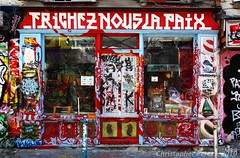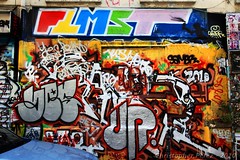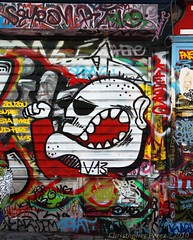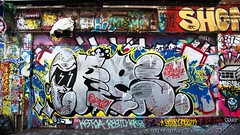
My wife and I visited Paris, France for over two weeks in the Fall, 2010. We wanted to see what it was like to visit this famous "city of lights" and do several things. First, we vowed to see none of the Paris icon tourist spots. What could we see in them that we haven't already seen in prior trips? Second, we wanted to live in an apartment and not out of a hotel. The idea was to begin to experience living in Paris as Parisians do. Third, we wanted to see if the city and it's citizens were as vibrant and alive as during those well documented times of the early 1920's.
Crossing the high tourist sites off our list of things to do freed us up to become flâneurs. We could walk or metro to places where normal life and living takes place. We could stop and talk with people when the urge hit. We were free to discover some incredible places not usually highlighted in guide books.

In this way we found Saint Germain l'Auxerrois, Saint Julian le Pavre, the Hotel Sully, several fine bistros (including Fois de l'isle), Gallery Verto-Dodat, and an ancient church around the corner from Sacre Cour. We wedged through the crowds around the pet shops that line the river Seine. I got to walk through the grève of September 23rd and see how the French unions are alive and active in trying to protect the working class from excessive corporate greed.
Living in an apartment was a wonderful way to participate in life and living in Paris. We prepared many of our meals in the apartment. Buying food in Paris was really no more expensive than buying food in the States, and it tasted much better too (the European food system isn't broken like it is in the USA). Being centrally located on l'isle St. Louis allowed us easy access to anything our hearts desired.

When it came time to see if the Parisian culture was still alive, vibrant, and informed, I could think of no better measure than to find and appreciate Paris streetart. While this may seem odd to some, streetart can be a barometer used to measure the level and volume of art a culture has under development. Streetart, by its nature, is transitory and ephemeral. None of it will ever hang in an "official" gallery. None of it will ever be appreciated by the monied conservative class.
Yet, the form, style, and content of streetart can inform even the casual observer about the level of artistic activity. For me, when art spills out into the streets and onto the buildings and vehicles, it tells me that people are demanding to be heard because they feel they have something important to say. Without access to more formal, traditional art outlets, streetart becomes one of the few public sharings of ones work available.

We visited rue Denoyez. The entire street has been given (or taken?) over to street artists. New works are constantly under development. New ideas are continually being expressed. New visions appear to be explored.
What impressed me most about Paris streetart is its level of sophistication. Artists seem well informed and aware of cultural pressures. They seem to be using these pressures to drive their work. While it may be difficult for me to see outright, I felt a vibrancy, an aliveness about some of the work.

Next time we visit Paris, I want to again seek out a bit of street art. There are more places than just Belleville to visit, too.